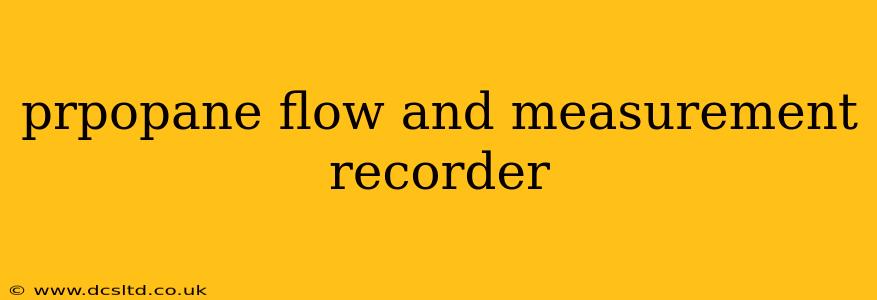Accurate propane flow and measurement recording is crucial for safety, efficiency, and regulatory compliance. Whether you're managing a large-scale industrial operation or a smaller residential system, understanding how propane is measured and recorded is essential. This comprehensive guide explores various methods, technologies, and best practices for precise propane flow measurement and data logging.
What are the different methods for measuring propane flow?
Several methods exist for measuring propane flow, each with its own advantages and disadvantages depending on the application and desired accuracy. These include:
-
Positive Displacement Meters: These meters measure the volume of propane by physically trapping and counting discrete volumes of gas. They are highly accurate, particularly for low flow rates, and are commonly used in residential and smaller commercial settings. However, they can be more expensive and less suitable for high-pressure applications.
-
Turbine Meters: These meters use a turbine wheel that spins proportionally to the flow rate of the propane. They are suitable for higher flow rates than positive displacement meters and offer good accuracy. However, they can be susceptible to wear and tear, requiring regular maintenance.
-
Ultrasonic Meters: These meters utilize ultrasonic waves to measure the velocity of the propane flowing through a pipe. They are non-invasive, requiring no moving parts, which makes them highly reliable and low maintenance. However, they can be more expensive than other methods.
-
Orifice Plates: These are simple and inexpensive devices that create a restriction in the flow path, causing a pressure drop proportional to the flow rate. The pressure difference is then measured to calculate the flow. While cost-effective, orifice plates have lower accuracy compared to other methods, and regular calibration is needed.
What are the common types of propane flow recorders?
Propane flow recorders are essential for logging and analyzing flow data. They can range from simple mechanical gauges to sophisticated digital systems. Common types include:
-
Mechanical Chart Recorders: These recorders use a rotating chart and pen to graphically display the flow rate over time. They are simple and reliable but offer limited data analysis capabilities.
-
Digital Flow Recorders: These recorders utilize electronic sensors and processors to capture flow data digitally. They often provide more advanced features like data logging, remote monitoring, and alarm functionalities. Data can be easily exported for analysis and reporting.
-
Data Acquisition Systems (DAS): These systems are often employed in larger installations and integrate multiple sensors, including flow meters, pressure gauges, and temperature sensors, to provide a comprehensive overview of the propane system. They can offer extensive data logging, analysis, and reporting capabilities.
How is propane flow data used?
Accurate propane flow data serves multiple purposes, including:
-
Inventory Management: Tracking propane flow helps businesses accurately monitor stock levels and optimize ordering to avoid shortages or excess inventory.
-
Leak Detection: Unusual fluctuations in flow rates can indicate leaks in the system, enabling early detection and preventing potential safety hazards.
-
Billing and Revenue Management: Accurate flow measurement is crucial for fair and precise billing to customers.
-
Process Optimization: For industrial applications, flow data analysis helps optimize processes and improve efficiency.
-
Regulatory Compliance: Many jurisdictions have regulations regarding the safe handling and monitoring of propane, requiring accurate flow measurement and recording.
What are the best practices for propane flow and measurement recording?
Implementing best practices ensures accurate and reliable data:
-
Regular Calibration: Regularly calibrate flow meters and recorders to maintain accuracy.
-
Proper Installation: Ensure proper installation of flow meters and recorders to avoid errors and ensure accurate readings.
-
Data Backup and Security: Implement a reliable data backup and security system to protect valuable flow data.
-
Regular Maintenance: Regularly inspect and maintain flow meters and recorders to extend their lifespan and maintain accuracy.
-
Operator Training: Train operators on the proper use and maintenance of flow measurement equipment.
What are some common problems with propane flow measurement?
Several issues can affect the accuracy of propane flow measurements:
-
Temperature Fluctuations: Temperature changes can affect the density of propane, impacting flow readings.
-
Pressure Variations: Changes in pressure can also influence flow rates, potentially leading to inaccurate measurements.
-
Meter Wear and Tear: Over time, flow meters can wear out, affecting their accuracy.
-
Improper Installation: Incorrect installation of flow meters can lead to significant measurement errors.
This guide provides a comprehensive overview of propane flow and measurement recording. By understanding different measurement methods, recorders, and best practices, you can ensure accurate data for safety, efficiency, and regulatory compliance. Remember to consult with qualified professionals for installation, maintenance, and system design.
